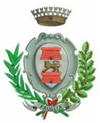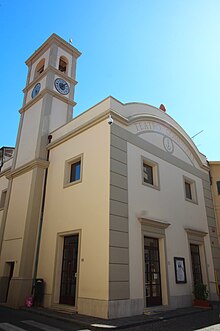Fauglia
| Fauglia | ||
|---|---|---|

|
|
|
| Country | Italy | |
| region | Tuscany | |
| province | Pisa (PI) | |
| Coordinates | 43 ° 34 ′ N , 10 ° 31 ′ E | |
| height | 91 m slm | |
| surface | 42 km² | |
| Residents | 3,629 (Dec 31, 2019) | |
| Population density | 86 inhabitants / km² | |
| Post Code | 56043 | |
| prefix | 050 | |
| ISTAT number | 050014 | |
| Popular name | Faugliesi | |
| Patron saint | San Lorenzo (August 10th) | |
| Website | Fauglia municipality | |
 Panorama of Fauglia |
||
Fauglia is an Italian commune in the province of Pisa in the Tuscany region with 3629 inhabitants (as of December 31, 2019).
geography
The place is located in a hilly landscape approx. 20 km south of the provincial capital Pisa , approx. 65 km southwest of the regional capital Florence and approx. 25 km east of Livorno near the Via Emilia and the Via Tosco-Romagnola . The place is in the climatic classification of Italian communities in zone D, 1 682 GR / G.
Fauglia lies on the western side of the river Era , which does not touch the local area. Important rivers in the municipality are the Isola (6 of 15 km in the municipality) and the Torrente Tora (4 of 27 km in the municipality).
Districts ( frazioni ) are Acciaiolo (34 m), Luciana (112 m), Poggio Pallone (51 m) and Valtriano (11 m).
The neighboring municipalities are Collesalvetti ( LI ), Crespina Lorenzana and Orciano Pisano .
history
It is very likely that the name of the place comes from the Latin faba (bean), which became Fauglia via Favul (l) ia Castrum .
The area has been used for agriculture since ancient times. The first settlements on the territory of the municipality emerged in the Middle Ages. The place is mentioned in sources from the 12th century, including the church of San Lorenzo and a castle. After belonging to the sphere of influence of the Republic of Pisa, the place came from 1345 for about half a century under the rule of Count Gabriello della Gherardesca , who had incited the people against the Pisan rule. At the beginning of the 15th century, Fauglia came under Florentine rule after a long siege . After a revolt in 1431, the Florentines destroyed the fortifications of Fauglia, including the old castle. The town owes the building of some elegant aristocratic palaces to the rule of the Medici Grand Dukes.
Fauglia, like the neighboring communities, was badly damaged in an earthquake in 1846.
Culture and sights
The townscape of Fauglia is mainly characterized by buildings from the period between the 17th and 19th centuries, including some elegant villas such as Villa Trovarsi , where the actresses Marta Abba and Cele Abba lived. Other villas are Villa Negri , Villa Arnia and Villa Rosselmini in Luciana.
The town hall ( Palazzo del Comune ) in classical style dates from 1875. The theater ( Teatro comunale ) of Fauglia was built in the middle of the 19th century.
Churches
- Chiesa di San Lorenzo - An old parish church is attested from 1251. After the collapse in the earthquake of 1846, the ruin was abandoned and rebuilt in another location in 1864. It has a simple facade in the classical style. The steeple of the old church (17th century) has been preserved.
- Chiesa di Santa Lucia - The church in the Luciana district was built in 1740 as an extension of a building mentioned in 1227. The church was badly damaged in the earthquake of 1846 and restored in 1856.
- Chiesa di Santa Margherita da Cortona - Church built in 1958 in the Valtriano district
economy
The area around Fauglia is particularly fertile and rich in water, and therefore the place has always been an agricultural center. Today the viticulture is still important, but a large part of the population works in other areas of industry, handicraft, especially wood processing and textiles, as well as in tourism.
Community partnerships
Fauglia maintains the following places community partnerships :
- Semriach (Austria)
- Gmund am Tegernsee (Germany)
Regular events
- Fiera paesana - village festival in early August
- Festa patronale - Festival of the patron saint, San Lorenzo, on August 10th
- Fiera d'ottobre - village festival in mid-October
Sons and daughters of the church
- Raffaele Di Paco (1908–1996), Italian racing cyclist
literature
- Emanuele Repetti: FAUGLIA, FAULLIA (Favulliae Castr.) In Val di Tora. In: Dizionario Geografico Fisico Storico della Toscana (1833–1846). Online edition of the University of Siena (PDF, Italian)
Web links
Individual evidence
- ↑ Statistiche demografiche ISTAT. Monthly population statistics of the Istituto Nazionale di Statistica , as of December 31 of 2019.
- ↑ Website of the Agenzia nazionale per le nuove tecnologie, l'energia e lo sviluppo economico sostenibile (ENEA), accessed on June 15, 2017 (Italian) (PDF; 330 kB)
- ↑ Official website of the Sistema Informativo Ambientale della Regione Toscana (SIRA) on the rivers in Fauglia , accessed on July 9, 2017 (Italian)
- ↑ Official website of the ISTAT ( Istituto Nazionale di Statistica ) for the districts 2001 in the province of Pisa, accessed on July 9, 2017 (Italian)
- ^ Official website of the parish on parish partnerships , accessed on July 9, 2017 (Italian)





